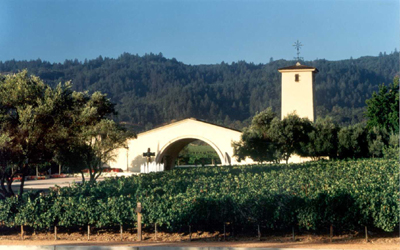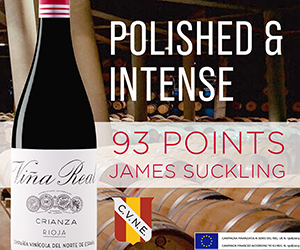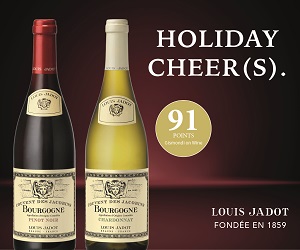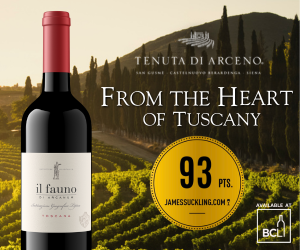It was February 20, 1962 when astronaut John Glen piloted the "Friendship 7" spacecraft on the first, US manned mission completing a successful three-orbit tour around the earth.
Four years later in a seemingly unrelated event the Robert Mondavi Winery open for business in a bucolic little valley north of San Francisco at Oakville, California.
In those days Napa was about as far away from France and the centre of the wine world, as the moon must have appeared to NASA scientists working at Kennedy Space Centre.
Improbable as it must have seemed at the time, John Glenn's foray into space would begin a technological revolution that would catapult the Americans onto the moon in less than decade and twenty years after that play major role in transforming the art of wine growing at Robert Mondavi.
Remote sensing from space is perhaps best known for its military applications but for nearly a decade its exactly what the folks at Robert Mondavi and scientists at NASA's Ames Research Center in California have been employing to enhance Mondavi wines and the results (in the wine glass) are stunning.
Knowing about what's going on in the vineyard has been at the heart of winemaking since grapes were first planted although obtaining such information required a lifetime of harvests not to mention uncountable forays into the vineyard by winemakers walking the rows one-by-one.
To be sure, everyone still walks the vineyards at Mondavi but now when they enter a specific block, (before, during and after every growing season), they do so with a wealth of computer analysed information that leaves no stone unturned -- or is that they leave every stone exactly where it was?
Tim Mondavi, winegrower and managing director for Robert Mondavi likes to use advanced remote sensing technologies to better understand the subtle nuances of his vineyards.
By combining decades of research and record keeping on its vineyards with the nuances of high altitude photography, Mondavi's vineyard team has built a virtual library of information about vine vigour - block by block.
By comparing field measurements of soil and plant chemistry to the remote sensing images the winery is beginning to determine the reasons for the observed differences in plant growth throughout its vineyards. As a result each vineyard block has been highly delimited leading to a highest and best use principal for every vine.
During the end of the 2002 growing season, director of winemaking Genevieve Janssens, was not just walking the rows and tasting the grapes in preparation for harvest; she was using a hand-held, wireless device to select which sides of the rows were to be picked by the crews.
The palm-size device transmits the instructions back to the winery where it's downloaded, printed and given to the picking teams the following morning.
Mondavi's work with NASA has lead to a greater understanding of vineyard terroir and all those minute changes in soil, microclimate, slope and drainage that result in distinct characteristics and flavours in the grapes.
Today, not only are the grapes planted on specific soils known over time to be the most simpatico but they are spaced, watered, pruned, shoot thinned, green harvested and generally babied until harvest all based on analysis which begins from outer space.
If that isn't thorough enough the use of handheld GPS devices allows Janssens to literally harvest from one side of the vine (where the fruit is riper)and that means no more mixing ripe and under ripe tannins.
That said change and information doesn't come without controversy. Mondavi wines are not what they used to be according to some writers, notably US wine scribes James Laube of the Wine Spectator and Robert Parker both of whom had unflattering things to say about the style of Mondavi wines in recent years.
It's possible Laube and Parker were analysing the transition rather than the completion of what I think is a new and better Mondavi style. I used the word "completion" loosely because Tim Mondavi has been tinkering with his wines (and as you have just read, his vineyards) since the day he entered the winery and there's no reason to believe he won't continue to fine-tune his wines forever.
Has the Mondavi team been influenced by its global ventures. You bet it has. Has it changed the style of its wines, the answer is again, yes. Is it a natural evolution? Of course it is, in fact I can't imagine anyone making wine in California today the way it was made in the 70s.
If you take into account the global perspective the Mondavi's have including the invaluable opportunity of working in France, Italy, Chile and most recently Australia, it seems patently obvious the family's wines are bound to evolve.
Still my tastings (which date back to the late 1970s) don't lead me to think the wines are not Californian. On this issue Tim Mondavi has written, "at home in California, we have always pursued wines that reflect the richness and ripeness of our climate while adding dimensions of elegance and finesse that we associate with the great wines of the world."
Elegance and finesse are the keywords in that quote and it's those attributes which could startle anyone with a California palate.
The older I get the more I believe in the less than scientific theory that the wines of winery more often than not reflect the personality of a winemaker. In Tim Mondavi's case thoughtful, restrained, and balanced describes the man and his wines.
Mondavi has expressed his concern about big clumsy wines on almost every occasion we have a met. Overripe, high alcohol, over-oaked wines designed to win tastings rather than fulfill the more appropriate purpose of enhancing a meal have long been abandoned by the experienced winemaker.
To get to wines that rely on layers of flavour, balance and elegance the Mondavi winemaking and wine growing team has experimented freely. As result an entirely new winemaking facility has been built at the Oakville To Kalon site to replace the mid-60s stainless steel facility that was itself a trendsetter in the early days of the rebirth of the California wine industry.
The two most prominent post phylloxera developments at Mondavi are high-density planting (the Mondavis now boast the largest collection of high-density vineyards in California) and an all oak fermentation process to complement the gentle handling from harvest through the cellar, and bottling wines without filtration.
The new, state-of-the-art, multi-level To Kalon Fermentation Cellar features 56, $27,500 new oak fermenters. The fermenters are hand made in Cognac, France by a team of Taransaud coopers before being disassembled and shipped to Oakville where they were reassembled and installed in time for the 2000 harvest.
Tim Mondavi and many other progressive winemakers believe the large wooden fermenters enhance aromas, flavours and complexity in red wine, while at the same time lending the wine an added density without added tannin.
Since most of you will have yet to taste the latest 2000 reds from Mondavi you can only take my word that not only are they different and better.
In a vineyard tasting of two 2000 Cabernet Sauvignon (one grown at the highest density 4'x4' or 2700 vines per acre; the other the more normal 8'x12' spacing or 450 vines per acres) the difference in flavour and texture were dramatic.
The high density wine was darker in colour and richer in soft tannins and fruit compared with the almost watered down flavours of the sample made form vineyards planted to a lesser density.
Still reeling from that experiment I tasted another pair of 2000 Cabernet Sauvignons this time one fermented in stainless steel the other made in the latest oak vats at To Kalon.
The results mirrored the differences noted during the high-density tasting. This time the cabernet fermented in the all-oak vats was plusher, rounder and more sensuous in the mouth not to mention well-stuffed and surprisingly easy to sip.
The stainless steel version was quite tight and standoffish and not really out of character but certainly not near as charming or as inviting as the oak fermented version.
Now just imagine what a cabernet made with high density fruit and fermented in those new oak vats and I think you get the picture where Robert Mondavi is heading.
When you think about it each technique allows the winery to make maximise the quality of its high-end, reserve wine which in a depressed market such as the one most California wineries will face for years to come isn't all that bad a strategy.
Mondavi will also cut production of its top end wines to further increase quality and by default improve all of the wines below the top end via the trickle down technique.
With nearly three decades of experiments behind it there is nothing to suggest the folks at Mondavi will not continue to carry on business as usual for another generation. Of course the usual is anything but at Robert Mondavi Winery where the wines continue to evolve with time.
Should we ever get to Mars in my lifetime one can only guess how the knowledge gathered to land on the red planet will impact winemaking, whatever the outcome count on it happening first at Robert Mondavi.

 quicksearch
quicksearch






